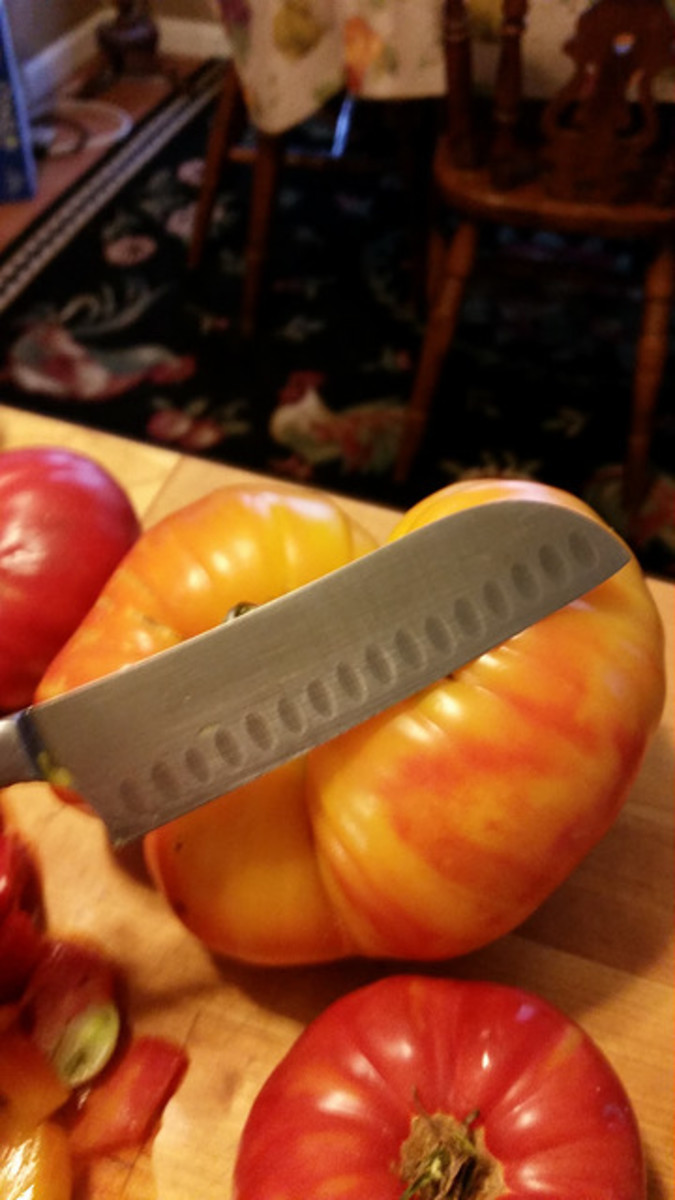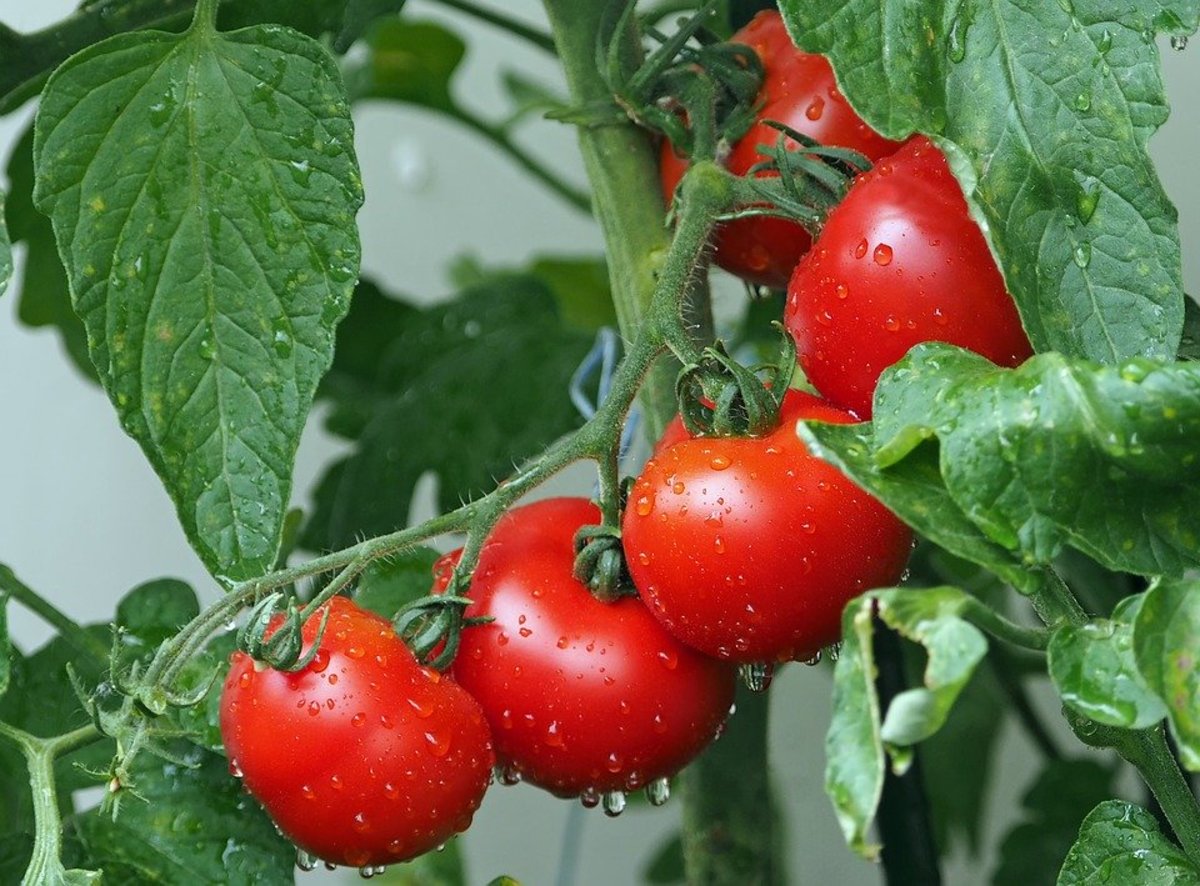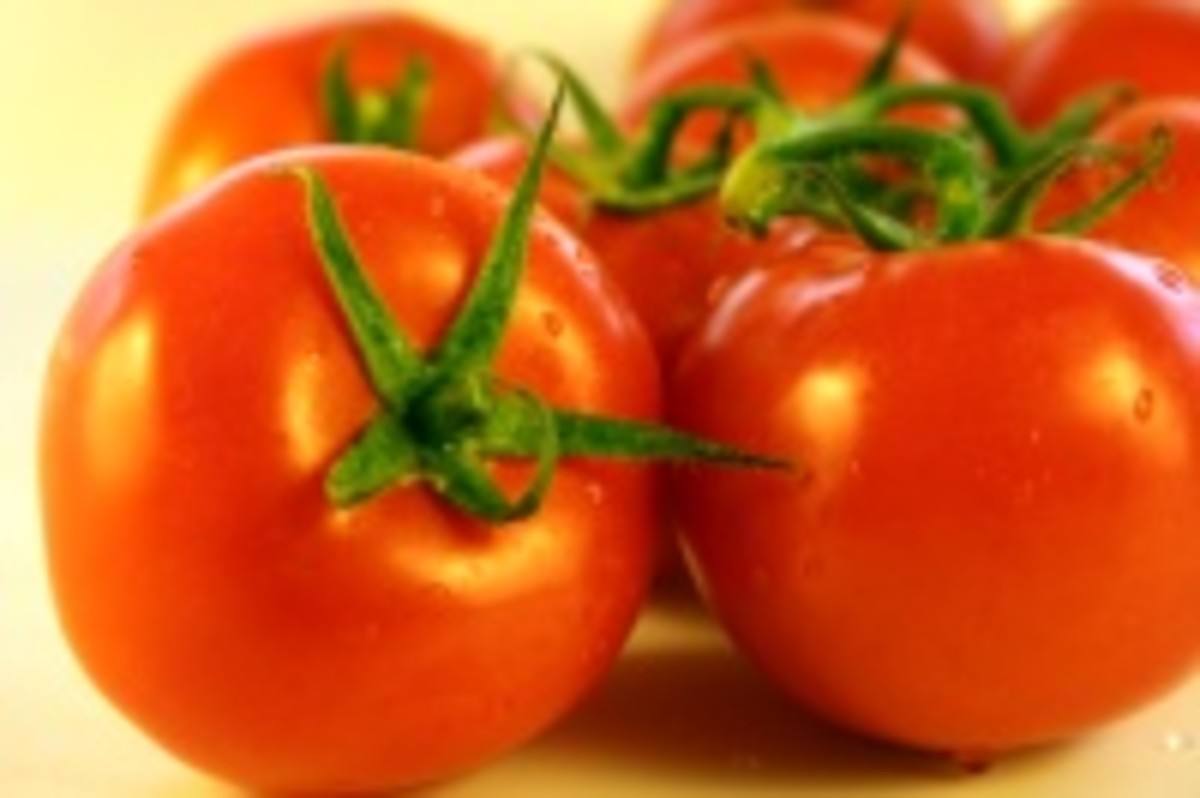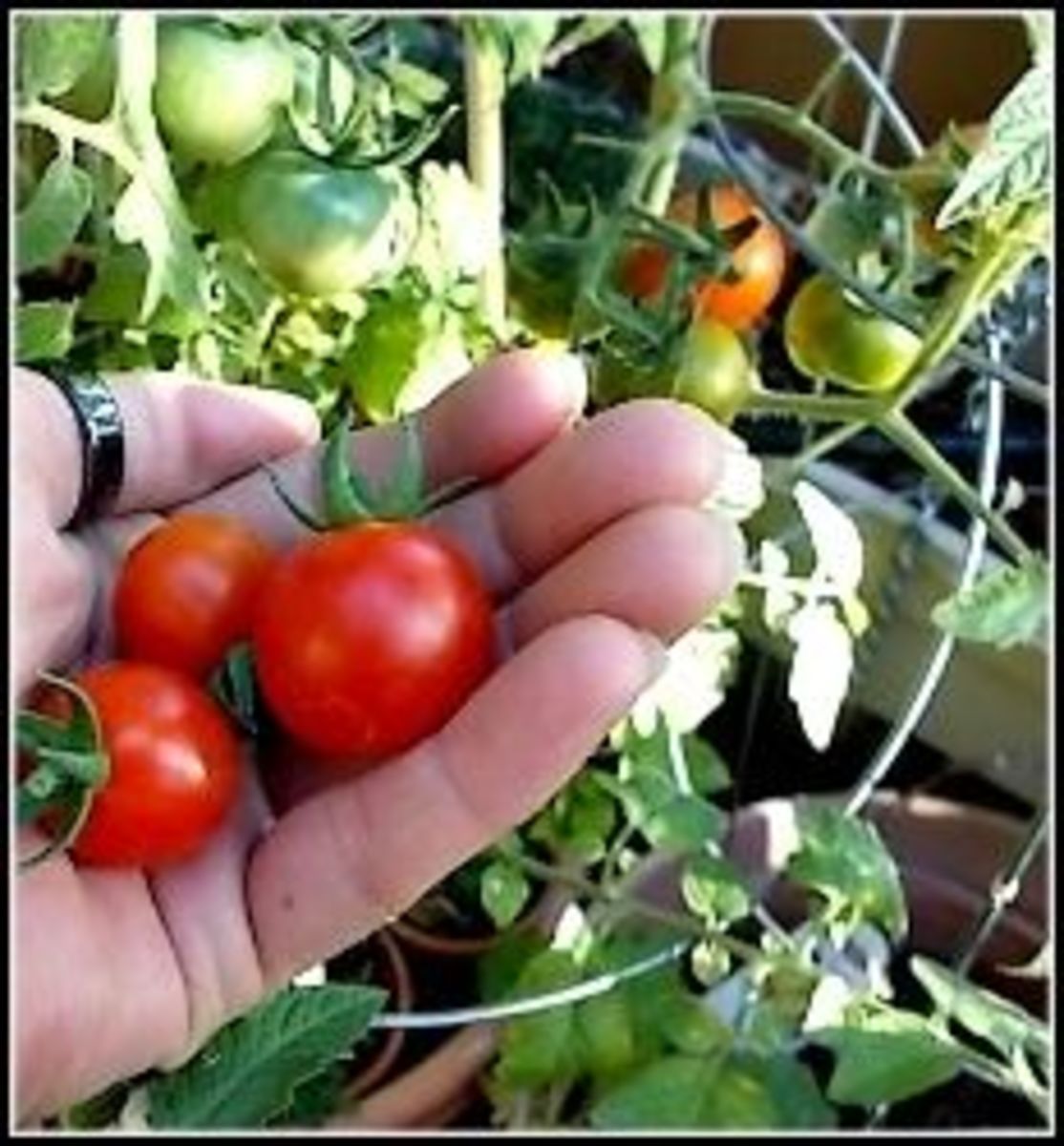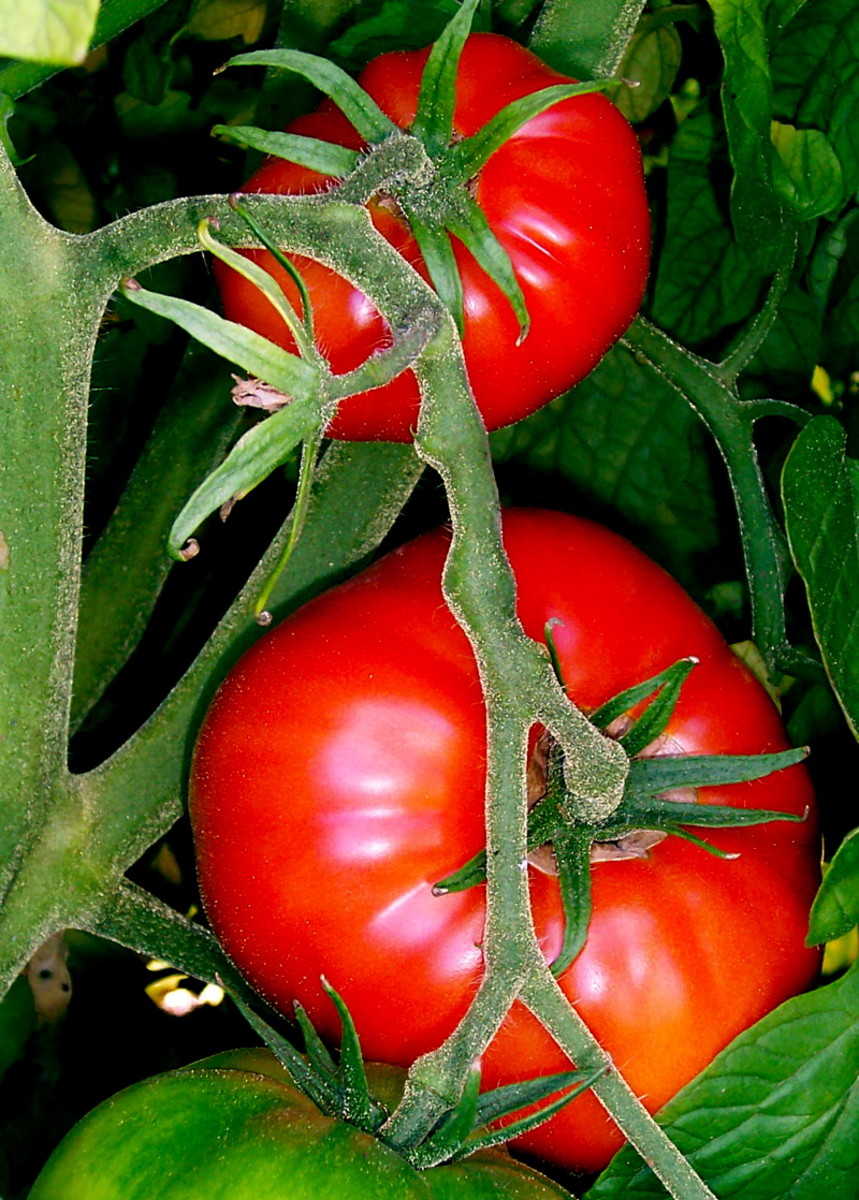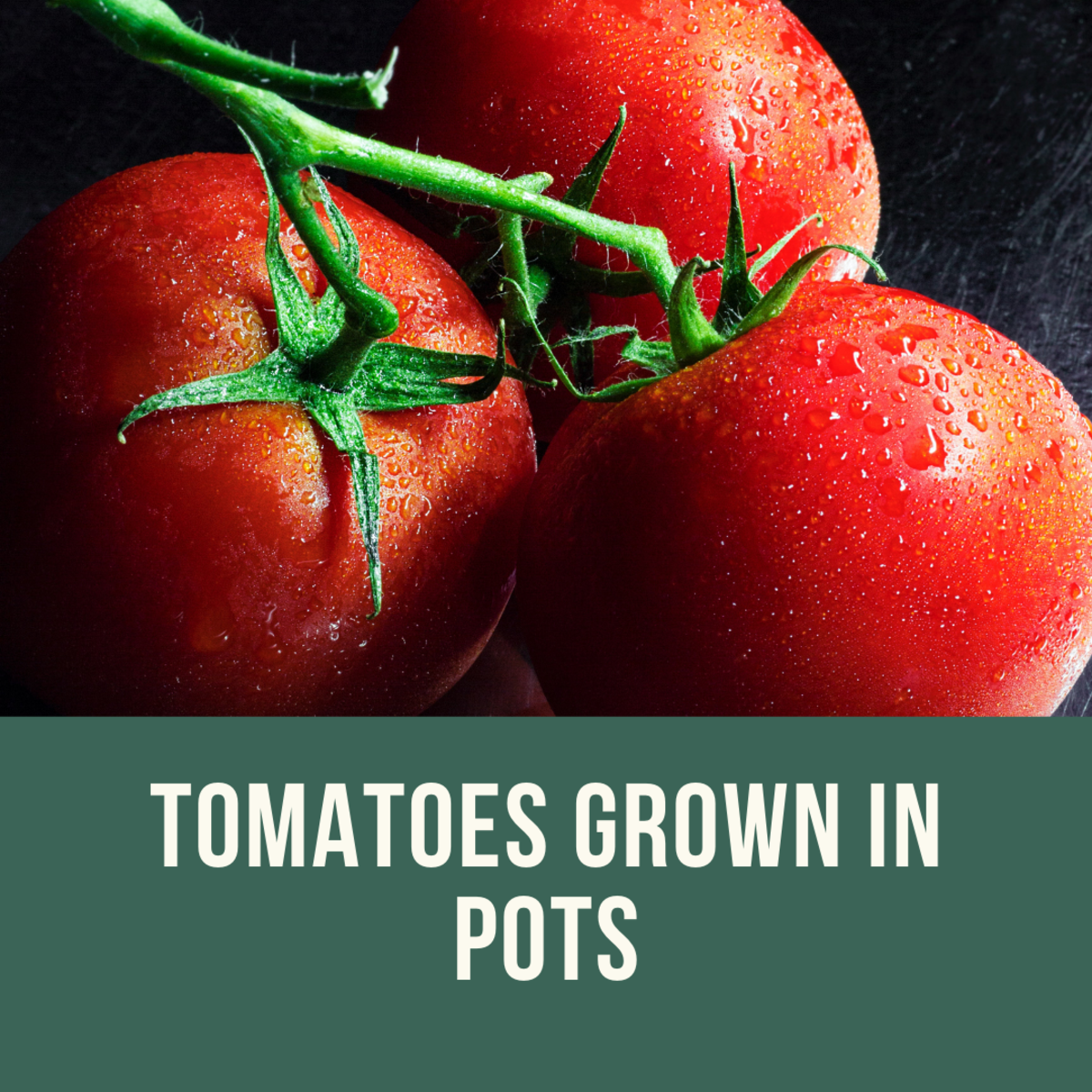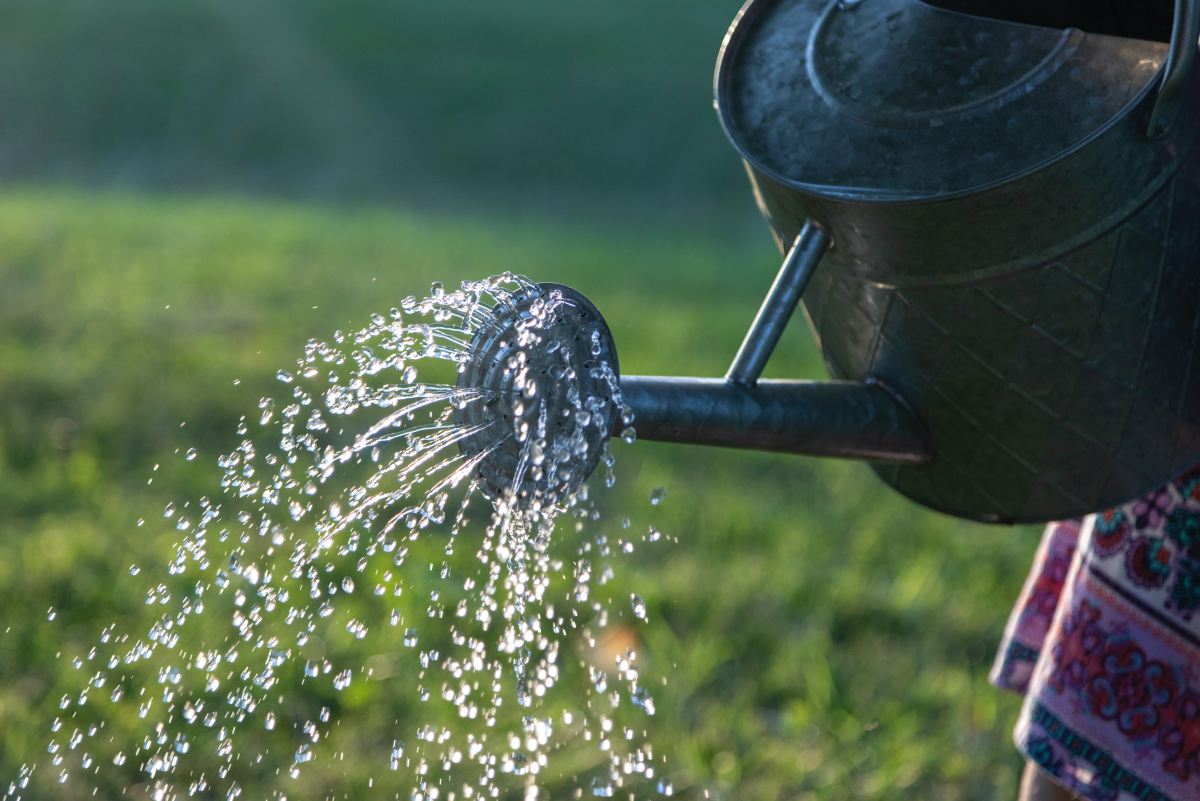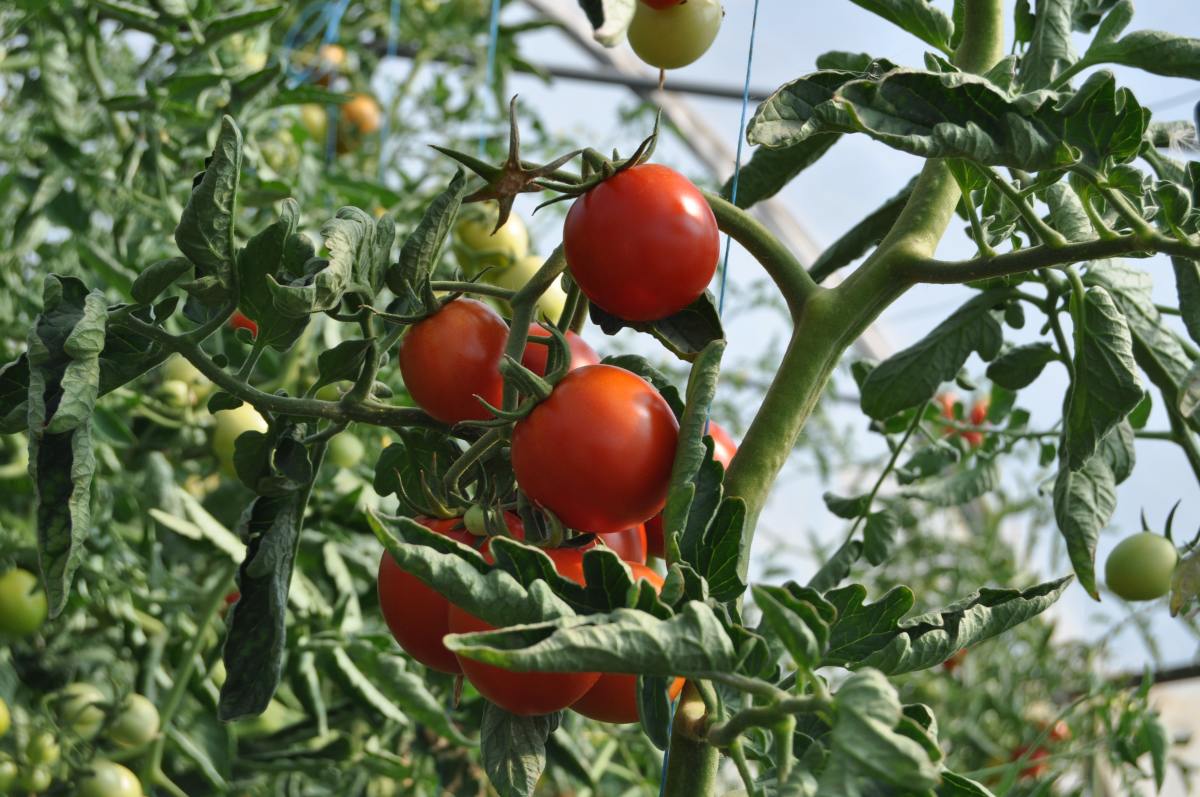- HubPages»
- Home and Garden»
- Gardening»
- Planting Vegetables
Growing Fantastic, Delicious, Prolific Tomatoes
Tomato
The tomato is one of the most popular plants to grow in the garden, and in reality is not a vegetable, but a fruit, even though some people like to debate that fact. There is a wide variety of tomatoes to choose from, including the giant slicing tomatoes to a small sweet cherry tomato; most of which I like.
It seems the problem of identifying it as a vegetable by most people comes from the way it is consumed; usually with other vegetables, or in its being cooked in a savory manner, instead of sweet-cooking them.
Oxford Dictionary says this:
"The confusion about 'fruit' and 'vegetable' arises because of the differences in usage between scientists and cooks. Scientifically speaking, a tomato is definitely a fruit. True fruits are developed from the ovary in the base of the flower, and contain the seeds of the plant (though cultivated forms may be seedless). Blueberries, raspberries, and oranges are true fruits, and so are many kinds of nut. Some plants have a soft part which supports the seeds and is also called a 'fruit', though it is not developed from the ovary: the strawberry is an example."
Either way, they are beloved by gardeners, and used in a plethora of recipes and dishes by cooks.
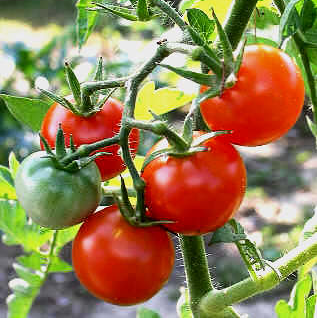
Varieties of Tomatoes
There are so many varieties of tomatoes that it can boggle the mind of even someone that has been growing them for many years. I've grown them professionally in the past, and at that time the choices and types or extraordinary, and there are far more tomato options today then there were at that time.
One way to start to whittle away at the varieties is to start with the zone you live in and go from there.
Secondly, understand why it is you're growing them. Sometimes gardeners will use only one tomato for all occasions, so it comes down to hardiness and how prolific they are.
For me, commercial growing aside, I enjoyed cherry tomatoes for salads and picking off the vine and eating them; a basic tomato for general use; and a Roma tomato for sauces.
If you want to try out some different types of tomatoes, there are a number of them in various colors and sizes to experiment with.
They are also great if you want to sell some in a stand, as they will differentiate yourself from others, or those who are growing them in their own gardens just like you are.
What Determines Tomato Choices?
Most tomato choices will be based upon what I mentioned above, so the other factors are the length of the season you have in the zone you live in, along with traits that may be conducive to your area.
When I lived in northeastern Texas, it was hot and humid, with summer temperatures averaging at least 95 degrees a day, and humidity almost the same.
So I bought tomatoes varieties that set well in hotter weather. Most people would be surprised how they could sit out in the full sun under those conditions and produce prolifically.
To show how important the variety was in that environment, I got cute one year and on the bad advice of a greenhouse manager that talked me into buying what he said was a high producer in the area, I literally planted hundreds of tomato plants and didn't get 1/20th of the production I got out of my former plants.
Sometimes it is right when something isn't broken not to attempt to fix it, unless you perform a small trial to see if what is asserted is actually true. I learned that lesson the hard way.
For northern areas, choosing varieties that mature quicker are the obvious choice, dependent on how far north you live.
Determinate or Indeterminate
If you haven't done much studying on tomato plants, you won't know that they are categorized as determinate or indeterminate. I'm going to describe them in simple language so we all can understand them, and not get too technical.
At the basic level, a determinate plant is one that has a shorter ripening season. Some of you may have acquired these types without knowing it and thought something was wrong when they stopped producing. It's simply the type of tomato it was in many cases.
Indeterminate tomatoes are the types that most of us who garden use. Once they start bearing fruit, they continue on all the way till the first frost, or at least close to it.
Commercial growers will use the determinate type more, as they're looking to harvest a batch close together to deliver to market, and not attempt to squeeze out more harvest over time.
If you want to do some canning, determinates can work well, especially if you want to do it all at one time rather than throughout the growing season.
Best Planting Time
The best time to plant, as in other planting best practices, is related to what particular zone you live in. In zones with shorter growing seasons, there is only one time to really plant, while in some warmer zones, gardeners will plant twice to secure a better harvest.
No matter what zone though, it works best to either start some seeds indoors to have some seedlings ready when warm weather hits, or to buy some transplants early and baby them until you can plant them outdoors.
I've even placed some tomatoes in pots and left them there for the entire growing season; placing them out every day and taking them in if there was any chance of a frost. Obviously there were a limited number of potted tomatoes, but that didn't keep them from giving up a good harvest.
You could also transplant before the final frost date outside if you have a way to protect them on cooler nights. For me, I've used black plastic for my mulch of choice in those cases. Floating row covers which attract and hold heat is another option.
Of course the safest way is to simply wait until the last frost is past before transplanting tomatoes.
To me, doing both is a great way to ensure a good harvest, while having a backup plan in case an unusually hard frost hits the area. If you do experience that, spraying them with water before the morning sun hits them is one way to protect them as well. That means getting up very early.
Purple Organic Tomato Seed
Planting for Harvesting in Fall
Those who have grown tomatoes know as the season goes on, even the best of plants will slow down in the number of tomatoes on the plant. To get a nice, late batch of tomatoes, you can sow some in the middle of summer to have them ripen in the fall.
This only works if you have a longer growing season. It's doubtful even the quickest ripening tomatoes can produce fast enough for a second planting in the north; although maybe for green tomatoes some could work out okay. But in general, it's unlikely it would be a successful endeavor.
What's great for those who can plant tomatoes for a fall harvest is the disease that can harm tomato plants earlier in the season are now gone, and the plants can produce better tomatoes as a result.
You may want to try a different variety of tomato for the fall season, as it won't need to be the type that sets well in hot months to be prolific.
Plant your tomatoes for the fall harvest soon enough so you have at least a couple of weeks or more of fruit to pick. Count back from the average first frost date using the number 100 to work back from. That will ensure at least a couple of weeks, and for many types, it could provide you with a month of fall tomatoes to enjoy, depending on the variety you plant.
How to Plant
All you have to do as far as planting depth for a tomato is put it in the ground a little above the root ball that has grown. I've never had problems with that depth, and I doubt you will either.
If you've had to wait longer than expected, and the plant has grown a little taller, you may want to adjust accordingly. But for the smaller transplants, that depth will work fine.
It's impossible to give guidelines for tomato spacing, as it's completely determined by the variety or varieties you plant, and whether or not you're letting them grow without support, or you have them caged or trellised.
Letting them run usually gives you more tomatoes over the season, but you can lose some of the larger ones from them lying on the ground because you didn't see them through the foliage of the plant.
In this case, sometimes you will need up to 6 feet in space between tomato rows to have enough room to harvest them. I've learned through experience you can step on and break quite a few tomatoes if the plants are too close together.
If you stake or cage your tomato plants, you should get away with spacing of about a foot and a half to two feet. If you are trellising your plants, usually two feet to three feet is about the right space between plants.
Those who grow dwarf tomato plants can get by with about a foot between plants.
Square foot gardening is a little different. You can watch the video I included below to see how that can be done with tomatoes in a raised bed.
How to Plant 11 Tomato Plants in a Square Foot Raised Bed Garden
Fertilizing
Tomatoes respond well to a good dose of starter fertilizer when they are transplanted, so be sure to have that as part of your tomato regimen.
Once the tomatoes begin to form on the plant, you can then add some nitrogen fertilizer in the form of ammonium nitrate. The ideal time is when tomatoes are about an inch in diameter, or a little more. After the first application, do it two more times at three-week intervals.
After each time you fertilize, if the weather gets dry, then you will need to water thoroughly to ensure best results.
Cultivating
It's always good with most plants to cultivate early so you can get the competitive weeds before they root to deep and wide. Do this with your tomatoes as well, cultivating them consistently and shallow so you don't do any damage to the tomato roots while managing the weeds.
You can also mulch your tomato plants, using organic matter or black plastic. For organic mulch, I would still do at least one early cultivation, as unless it's very deep, you'll still get some weeds popping through. Plastic of course offers almost total protection.
The reason for cultivating in relationship to organic mulch is you don't want to place it over the soil and lock in the cold before it warms up. That would slow down the growth of the plant.
Black plastic will absorb the heat of the sun and help warm the soil, so it's not an issue there.
Staking or Trellising Tomatoes
If you have enough space, I wouldn't even bother staking tomatoes, as it can sometimes be more of a hassle than it's worth.
Now if you get a sore back or have a lot of tomatoes, you may want to reinforce them in some way. I've had hundreds of tomato plants at a time and only used reinforcement as an experiment, which I found with the varieties I used as resulting in less fruit. It wasn't worth the extra cost and work to me.
But for those with limited space and wanting to have an easier time harvesting tomatoes, staking tomatoes is a valid choice.
There are cages, trellises and stakes made for that purpose, or if you're handy, you can make them yourself. What is most important is whether the particular variety or varieties of tomatoes you're growing will work well with reinforcement. Not all do, so ask questions and check it out before committing time and money to it.
Having your tomatoes off the ground does help to secure those early tomatoes which aren't always seen. With regular tomatoes they can be among the largest of the year, so if you aren't diligent with tomatoes growing on the ground, staking them can help safe some of those early giants.
Also take into account how big your tomato plant will grow when reinforcing them. Some can grow many feet high, and you will have to consider the type of reinforcement to get best results for that particular tomato variety.
One thing for sure, unless you're growing dwarf tomatoes, that really small cage you see won't do the job for most varieties. Get the larger ones, or at least the medium-sized cages if that's the staking method you decide on for your tomatoes.
Video on How to Grow Tomatoes
Tomato Harvest
Unless you're harvesting some early green tomatoes to fry or for other purposes, the best time to harvest your ripe tomatoes is when the summer temperature is at about 75°F.
In the south that's of course an impossibility for most of the summer, so adjust that according to your area and the tomato variety you have chosen for best results in your zone.
Look for the best color before harvesting your tomato. In cooler climates you can let them get that nice red color before picking. In my experience, in warmer climates you have to pick them a little earlier because they get softer quicker, and the color isn't always true to actual ripeness because everything accelerates in warmer weather.
In that case a good-colored tomato could be a bad tomato, and a lighter red one a much better one. Harvest a little earlier and allow them to ripen indoors, even though you lose a little of the nutrients as a result. It's better to have some nutrition with good flavor than to have absolutely nothing.
Planting them for fall harvest helps in this case, where you should be able to get some nice, red, ripe tomatoes right off the vine.
If you're expecting a freeze in the fall, harvest all the tomatoes you want so you can ripen them indoors. Some people even pull up entire plants if they have a lot of fruit on them and store them upside down in a safe location.
Storage should be with a temperature of not more than 65°F.
Tomato Hornworms
The major pest for a tomato is the hornworm, which grow up to 3" longer or a little more, and is green in color. A horn grows near the back bottom of the worm, giving it its name.
If you have just a few plants, you could probably handpick the worms, although they can be difficult to see and can defoliate a plant quickly.
Be aware when you pick the worms that they are green inside, and if they're clinging to a stem or leaf, can break open and leave a lot of unpleasant residue on your fingers. Wearing gloves can help with that, as well as help you get a better grip on the body of the worm. Don't squeeze too hard when grabbing it, but just enough to be able to pull it off and dispose of the hornworm.
For those with a fair amount of plants the best deterrent is bacillus thuringiensis, which quickly manages any hornworm infestation. It's sold under a number of brand names. It's usually identified as B.t.
Finally, if the hornworms have what appears to be some weird looking larvae or cocoons on the back, that's a good thing, because it means a parasitic predator called braconid wasps have invaded the hornworm and its days are numbered.
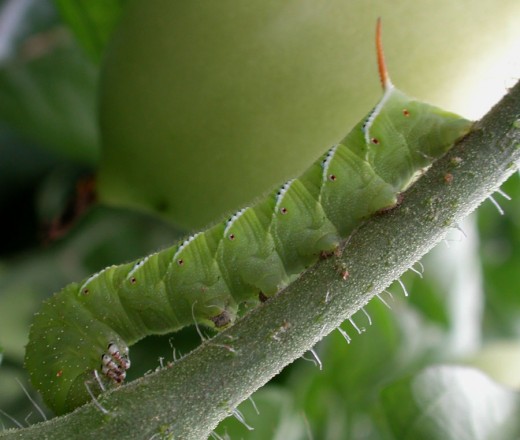
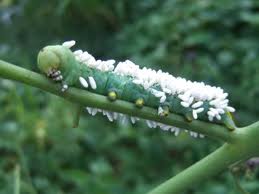
Diseases
There are several diseases that are predominant with tomatoes, including verticillium and fusarium wilts, septoria leafspot, and early blight.
The best protection for the major diseases of verticillium and fusarium wilts are to buy tomatoes resistant to the diseases. Many good varieties are resistant, so you should have no problem combating these soil-borne diseases, which are identifiable by wilting and yellowing of the leaves which cause the tomato to die early.
When you see a lot of small black spot on the leaves of a tomato plant, you are witnessing septoria leafspot. You'll know for sure if the black dots eventually turn white in the center, and then another small black dot ends up in the center of that white one. This will start on the lower leaves of a plant, and in moist conditions, will move up the plant. Using a fungicide when you first see the infected leaves is the way to combat it. Also remove the infected leaves right away, and clean you hands before touching anything else.
Some best practices for prevention of septoria leafspot include growing tomatoes in a raised bed for better drainage, water on the bottom and not directly on the plant, give them more space when planting, and mulch with black plastic to prevent the fungus from spreading to the plant.
With early blight, it can be recognized from the dead brown spots that are prone to originate on the lower leaves of the tomato and spreading up the plant from there.
The way you treat septoria leafspot is almost identical to the way you would treat early blight. An additional preventative is to use a variety that is somewhat resistant to early blight.
Blossom End Rot
Blossom end rot is caused by a calcium deficiency in the plant, and is identified by that dark, spoiled area we've all seen on our tomatoes at one time or another.
Usually the reason for a tomato to get blossom end rot is from not being watered consistently. That is what causes the loss of calcium because it doesn't move up into the plant to the fruit.
To prevent it give a couple of good drinks of water at least a couple of times a week. Warmer weather can trigger the problem by generating fluctuations in the water available to the plant.
If the plant develops it, only calcium sprayed on the tomato plant can extend its life. Calcium added to the soil doesn't work for this problem. There are some homemade remedies that work, but it's best to just buy a product made for that purpose commercially so you don't inadvertently do more damage to the plant.
Heirloom Tomatoes
Heirloom tomatoes have become very popular again, as there are many tomatoes available that you simply can't find anywhere else.
There are strengths and weaknesses to heirloom tomatoes because they're closest to tomatoes from the past that didn't have some of the protective traits like disease resistance bred into them.
They also have longer growing seasons so probably won't produce in the colder climates, although be sure to do some extra research if you want to give it a go.
As to the positive of the fruits, you will experience tastes and colors you simply can't find anywhere else with tomatoes. They could also be great if you sell them as a side business.
I wouldn't count on them for consistency, but they would sure be a nice diversion and experience.
Tomatoes
There's a reason tomatoes are the favorite of gardeners: they taste fantastic when garden-grown and ripened on the vine.
And other than a few potential problems which can in most cases be managed without too much effort, tomatoes are easy to grow when the gardener participates in best practices as outlined above.
They are a great addition to any meal; you can share them with family and friends; and if you're ambitious, grow them to make some money on the side.
All of this adds up to a great and enjoyable experience that everyone needs to have at least once in life. And when you do, you will catch the tomato bug, and it's doubtful it'll ever leave you.


